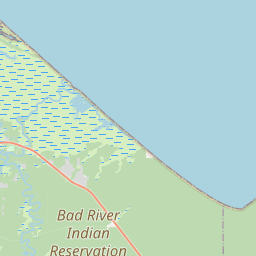Fleet Admiral William D. Leahy
Historical marker location:
Ashland, Wisconsin
( Marker is on Lake Shore Drive East (U.S. 2) 0.1 miles west of 20th Avenue East, on the right when traveling west.)
Marker installed: 1991







© OpenStreetMap contributors
Loading...
Searching for other points of interest within 3 miles of this location.The famous magician and escape artist Harry Houdini spent his early childhood in Appleton, Wisconsin.
About Ashland County
Ashland County Timeline
Ashland County, Wisconsin has a rich and diverse history that dates back thousands of years. The area was originally inhabited by the Ojibwe and other Native American tribes. European exploration and settlement began in the late 17th century, with French fur traders and missionaries establishing a presence in the region. The area was heavily involved in the fur trade, with trappers and traders using the nearby waterways to transport goods.
In the mid-19th century, Ashland County saw a significant influx of settlers due to the discovery of copper and iron ore deposits. Mining operations boomed, attracting people from all over the country. The city of Ashland was founded in 1854 as a mining town and quickly became a major center for shipping ore and supplies. The mining industry played a crucial role in the development of the county, providing jobs and economic growth.
The arrival of the railroads in the late 19th century further contributed to Ashland County's growth. The railroads improved transportation and allowed for the expansion of industries such as logging and agriculture. Timber became a major industry, with vast forests providing a steady supply of lumber. Agriculture also thrived, with dairy farming becoming particularly important.
Throughout the 20th century, Ashland County experienced both prosperity and challenges. The decline of the mining and logging industries in the latter part of the century had a significant impact on the local economy. However, the county has continued to adapt and diversify, with tourism and outdoor recreation becoming increasingly important. Ashland County is now known for its beautiful natural landscapes, including the Chequamegon-Nicolet National Forest and the Apostle Islands National Lakeshore, which attract visitors from all over the world.
In the mid-19th century, Ashland County saw a significant influx of settlers due to the discovery of copper and iron ore deposits. Mining operations boomed, attracting people from all over the country. The city of Ashland was founded in 1854 as a mining town and quickly became a major center for shipping ore and supplies. The mining industry played a crucial role in the development of the county, providing jobs and economic growth.
The arrival of the railroads in the late 19th century further contributed to Ashland County's growth. The railroads improved transportation and allowed for the expansion of industries such as logging and agriculture. Timber became a major industry, with vast forests providing a steady supply of lumber. Agriculture also thrived, with dairy farming becoming particularly important.
Throughout the 20th century, Ashland County experienced both prosperity and challenges. The decline of the mining and logging industries in the latter part of the century had a significant impact on the local economy. However, the county has continued to adapt and diversify, with tourism and outdoor recreation becoming increasingly important. Ashland County is now known for its beautiful natural landscapes, including the Chequamegon-Nicolet National Forest and the Apostle Islands National Lakeshore, which attract visitors from all over the world.
Ashland County Timeline
This timeline provides a glimpse into the major events and milestones that have shaped the history of Ashland County, Wisconsin.
- 1860: Ashland County is created by the Wisconsin State Legislature
- 1870: Ashland becomes the county seat
- 1870s: Logging and sawmills drive the local economy
- 1883: The Wisconsin Central Railroad reaches Ashland
- 1894: Ashland experiences a devastating fire that destroys most of the city
- 1900: The population of Ashland County reaches its peak
- 1920s: The decline of the lumber industry leads to a shift in the local economy towards tourism and agriculture
- 1940s: Ashland County contributes to the war effort during World War II
- 1970s: The Apostle Islands National Lakeshore is established, boosting tourism in the area
- 1990s: The population of Ashland County begins to decline